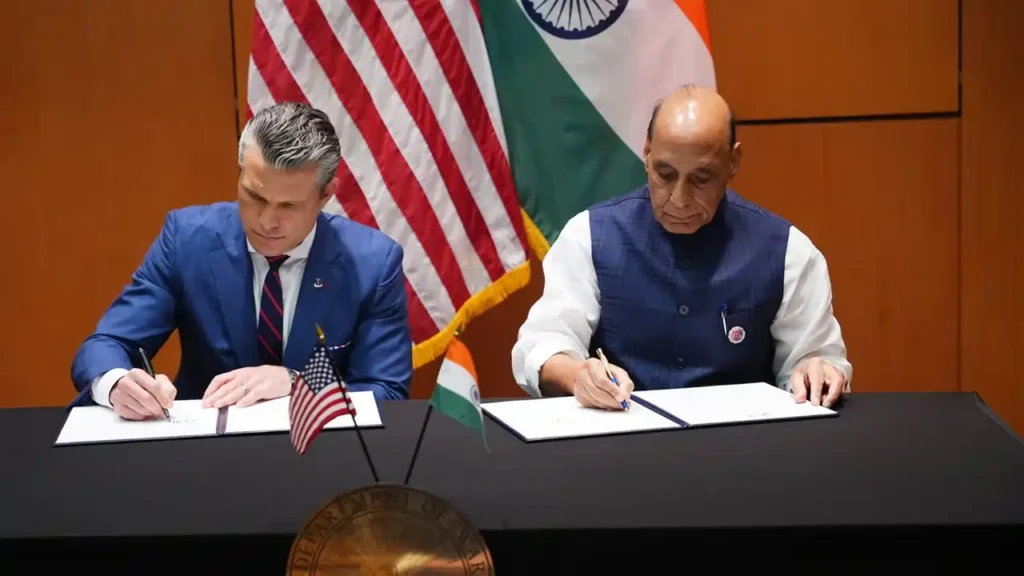New Delhi: India and the United States have signed a landmark 10-year Framework for the U.S.–India Major Defence Partnership, providing a unified vision and long-term policy direction to deepen defence cooperation across all sectors. The agreement, concluded on the sidelines of the 12th ASEAN Defence Ministers’ Meeting-Plus (ADMM-Plus) in Kuala Lumpur, marks a new phase in the bilateral strategic relationship between the two nations.
The framework was signed by India’s Defence Minister Rajnath Singh and U.S. Secretary of War Pete Hegseth, reaffirming the commitment of both governments to expand collaboration in defence technology, joint production, intelligence sharing, and regional security. The agreement builds upon earlier frameworks covering the 2005–2015 and 2015–2025 periods, setting a comprehensive roadmap for cooperation over the next decade.
According to the Indian Ministry of Defence, the framework seeks to guide the full spectrum of the India–U.S. defence partnership, including industry cooperation, operational interoperability, and strategic coordination. Both sides reviewed ongoing engagements and discussed measures to address emerging security challenges. The Ministry noted that the initiative would transform the scope and depth of collaboration between the two countries, consolidating their defence ties in line with their shared vision for a free, open, and rules-based Indo-Pacific region.

A Decade of Strategic Alignment
The signing comes at a time when bilateral relations have faced temporary strain over Washington’s decision to impose 50% tariffs on Indian goods, yet both governments have emphasized that defence cooperation remains unaffected. During their meeting, Singh and Hegseth reaffirmed that defence remains a cornerstone of India–U.S. relations and that the new framework will “usher in a new decade of partnership.”
Rajnath Singh described the agreement as a reflection of “growing strategic convergence” between the two democracies. In a post on X, he stated: “It is a signal of our growing strategic convergence and will herald a new decade of partnership. Defence will remain the major pillar of our bilateral relations. Our partnership is critical for ensuring a free, open, and rules-bound Indo-Pacific region.”
Secretary Hegseth echoed this sentiment, writing on X: “We’re enhancing our coordination, information sharing, and technology cooperation. Our defence ties have never been stronger.” He emphasized that the framework advances the bilateral partnership as a cornerstone for regional stability and deterrence, underscoring Washington’s recognition of India as a “priority partner” in defence cooperation.
Policy Continuity and Foundational Agreements
The new 10-year framework extends a long line of institutional mechanisms underpinning the India–U.S. defence partnership. Since the early 2000s, both countries have developed a series of foundational and enabling agreements designed to strengthen interoperability, logistics, and information exchange.
Key accords include the Logistics Exchange Memorandum of Agreement (LEMOA) signed in 2016, allowing reciprocal access to bases and logistics support; the Communications Compatibility and Security Agreement (COMCASA) of 2018, enabling India to procure secure U.S. communication systems; the Industrial Security Agreement (ISA) of 2019; and the Basic Exchange and Cooperation Agreement (BECA) of 2020, which facilitates sharing of geospatial intelligence.
In 2023, both sides launched the Defence Industrial Cooperation Roadmap, aimed at accelerating co-production and co-development of advanced technologies. Complementing this is INDUS X, a joint defence innovation ecosystem linking startups and industry players in both countries. A new initiative, the Autonomous Systems Industry Alliance (ASIA), has also been announced to promote collaboration in autonomous systems and robotics across the Indo-Pacific.
Expanding Defence Trade and Technology Collaboration
The defence trade between India and the United States now exceeds US$20 billion, reflecting significant growth in bilateral procurement and joint ventures. India’s defence inventory includes U.S.-origin platforms such as the C-130J Super Hercules, C-17 Globemaster III, and P-8I Poseidon aircraft, along with Apache, Chinook, and MH-60R Seahawk helicopters.
Recent industrial engagements have focused on jet engine co-production and advanced drone procurement. Negotiations are ongoing for the manufacture of GE F-414 engines for the Light Combat Aircraft (LCA) Tejas Mk2 fighters, while discussions continue for India’s acquisition of 31 MQ-9B High-Altitude Long-Endurance UAVs. Deliveries of GE F-404 engines for the LCA Tejas Mk1A are already underway.
The collaboration has also expanded into supply chain security and defence logistics, with both nations signing a Security of Supply Arrangement (SOSA) and a Memorandum of Agreement on Liaison Officer Assignments in 2024. These initiatives aim to ensure the uninterrupted flow of critical defence components and enhance real-time coordination between the two militaries.
Operational Interoperability and Joint Exercises
Operational cooperation remains a key pillar of the India–U.S. partnership. The armed forces of both countries engage regularly in bilateral and multilateral military exercises, enhancing tactical coordination and interoperability. Prominent bilateral exercises include Yudh Abhyas (Army), Vajra Prahar (Special Forces), and Cope India (Air Force).
India also participates alongside the United States in the Malabar naval exercise, conducted with Japan and Australia as part of the Quad framework, reinforcing shared maritime security objectives in the Indo-Pacific. In September 2025, Indian and American troops conducted the Yudh Abhyas exercise at Fort Wainwright in Alaska, followed by the U.S. submarine support ship USS Frank Cable visiting Chennai on a scheduled port call — highlighting sustained operational engagement despite trade-related tensions.
Building Defence Industry Linkages
A central feature of the new 10-year framework is its focus on defence industrial collaboration. The roadmap aims to foster partnerships in research, development, and production between major Indian and U.S. defence firms. Initiatives like INDUS X are intended to link start-ups, universities, and innovation hubs in both countries, while the Defence Industrial Cooperation Roadmap (2023) seeks to fast-track projects under the “Make in India” and “Atmanirbhar Bharat” initiatives.
India’s public sector giant Hindustan Aeronautics Limited (HAL) has expressed confidence that tariff-related disputes will not affect ongoing defence production negotiations. HAL Chairman D.K. Sunil stated in September that defence cooperation with the U.S. continues to progress, particularly in co-production of aircraft engines and components.
Strategic Context and Regional Implications
The signing of the defence framework occurs amid growing concerns over regional security and maritime stability in the Indo-Pacific. Both India and the U.S. have repeatedly underlined the importance of maintaining freedom of navigation and adherence to international law in the region — principles often challenged by rising strategic competition.
The Indo-Pacific has emerged as a focal point for both countries’ defence and foreign policies. The U.S. considers India a key partner in its strategy to promote a secure, rules-based order, while New Delhi views Washington as a reliable partner for modernizing its defence capabilities and diversifying its strategic options.
The agreement also aligns with India’s Act East Policy, which seeks to deepen political, economic, and security engagement with Southeast Asian nations. Rajnath Singh’s presence in Kuala Lumpur coincided with the ASEAN–India Defence Ministers’ Informal Meeting, which preceded the ADMM-Plus session scheduled for November 1. The discussions focused on maritime security, regional cooperation, and the evolving security architecture in the Indo-Pacific.
Enduring Partnership Despite Economic Tensions
Despite recent friction over U.S. tariffs on Indian exports and differences on trade policy, defence cooperation between the two democracies has remained resilient. The Ministry of Defence noted that both sides have sustained regular high-level engagements, including a telephonic conversation in May 2025 between Singh and Hegseth, where they reviewed progress on ongoing initiatives. Although Singh’s planned visit to Washington in August was postponed amid tariff discussions, both leaders reaffirmed their intent to advance defence ties through the new framework.
The signing of the agreement in Malaysia demonstrates that both governments are prioritizing security cooperation as a stabilizing factor in their broader bilateral relationship. Officials from both sides described the meeting as “constructive,” emphasizing that the framework provides a clear and unified policy direction to guide defence collaboration over the next decade.
A Unified Vision for the Future
The newly signed Framework for the U.S.–India Major Defence Partnership (2025–2035) institutionalizes strategic dialogues and expands cooperation in defence science, technology, and industry. It establishes mechanisms for policy alignment through apex forums such as the 2+2 Ministerial Dialogue, ensuring continuity and coordination in bilateral defence policy.
Both countries are expected to build upon this agreement through regular consultations, expanding cooperation in emerging domains such as cyber defence, space security, and artificial intelligence in military applications. The framework also promotes mutual logistics support, capacity-building, and increased defence trade under India’s Strategic Trade Authorization (STA Tier-1) status, which facilitates the export of sensitive technologies from the United States to India.
In its statement, the Ministry of Defence concluded that the partnership will continue to evolve through a blend of military-to-military exchanges, information sharing, defence industrial cooperation, and coordination with regional and global partners.
As Rajnath Singh stated after the signing, the framework symbolizes “a shared vision for security, stability, and prosperity in the Indo-Pacific.” Secretary Hegseth reaffirmed that sentiment, describing India–U.S. defence ties as being at their strongest point yet, and poised to grow even further in the coming decade.
FAQs
1. What is the India–U.S. 10-year defence framework signed in 2025?
The India–U.S. 10-year defence framework, officially titled the Framework for the U.S.–India Major Defence Partnership (2025–2035), is an agreement signed in Kuala Lumpur on October 31, 2025. It provides a long-term roadmap for strengthening cooperation between the two nations across defence technology, industry, logistics, intelligence sharing, and regional security.
2. Who signed the India–U.S. defence agreement and where was it concluded?
The agreement was signed by India’s Defence Minister Rajnath Singh and U.S. Secretary of War Pete Hegseth on the sidelines of the 12th ASEAN Defence Ministers’ Meeting-Plus (ADMM-Plus) in Kuala Lumpur, Malaysia.
3. What are the key objectives of the new 10-year defence framework?
The framework aims to provide a unified vision and policy direction for bilateral defence cooperation. Its priorities include joint production of defence equipment, technology sharing, strengthening military interoperability, and promoting regional stability in the Indo-Pacific. It also focuses on innovation and industrial collaboration under initiatives like INDUS X and the Defence Industrial Cooperation Roadmap.
4. How does this agreement affect India–U.S. relations amid recent trade tensions?
Despite trade frictions due to U.S. tariffs on Indian exports, both governments have reaffirmed that defence cooperation remains unaffected. The framework highlights mutual trust and strategic alignment, reinforcing defence as a cornerstone of India–U.S. relations and ensuring continuity of military and industrial collaboration.
5. What are some notable defence projects and exercises under the India–U.S. partnership?
Key defence procurements include C-17 Globemaster III, P-8I Poseidon, Apache and Chinook helicopters, and MH-60R Seahawk helicopters. Major joint military exercises such as Yudh Abhyas, Vajra Prahar, and Malabar enhance operational interoperability. Upcoming projects include manufacturing GE F-414 jet engines in India and procuring MQ-9B drones.

